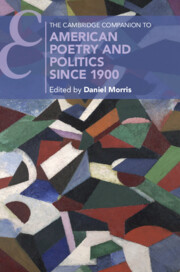Book contents
- The Cambridge Companion to American Poetry and Politics since 1900
- The Cambridge Companion to American Poetry and Politics since 1900
- Copyright page
- Contents
- Notes on Contributors
- Acknowledgments
- Introduction
- Chapter 1 The Space of Public Memory
- Chapter 2 Poetry and Propaganda
- Chapter 3 Depression-Era Poetics and the Politics of How to Read
- Chapter 4 The Politics and Poetics of Revolution
- Chapter 5 Wallace Stevens, Stanley Burnshaw, and the Defense of Poetry in an Age of Economic Determinism
- Chapter 6 The Line of Wit
- Chapter 7 US Poets on War and Peace
- Chapter 8 Institutions of American Poetry
- Chapter 9 African American Political Poetries
- Chapter 10 Our Terribly Excluded Blue
- Chapter 11 Poetry and the Prison Industrial Complex
- Chapter 12 “Oh Say Can You See”
- Chapter 13 The Political Resonances of Hip Hop and Spoken Word
- Chapter 14 Language as Politics in Twentieth- and Twenty-First-Century American Poetry
- Chapter 15 Renovating the Open Field
- Chapter 16 Transcultural Agency
- Chapter 17 Ecopoetry Now
- Chapter 18 The Politics and History of Digital Poetics
- Index
- Cambridge Companions to …
- References
Chapter 3 - Depression-Era Poetics and the Politics of How to Read
Published online by Cambridge University Press: 27 April 2023
- The Cambridge Companion to American Poetry and Politics since 1900
- The Cambridge Companion to American Poetry and Politics since 1900
- Copyright page
- Contents
- Notes on Contributors
- Acknowledgments
- Introduction
- Chapter 1 The Space of Public Memory
- Chapter 2 Poetry and Propaganda
- Chapter 3 Depression-Era Poetics and the Politics of How to Read
- Chapter 4 The Politics and Poetics of Revolution
- Chapter 5 Wallace Stevens, Stanley Burnshaw, and the Defense of Poetry in an Age of Economic Determinism
- Chapter 6 The Line of Wit
- Chapter 7 US Poets on War and Peace
- Chapter 8 Institutions of American Poetry
- Chapter 9 African American Political Poetries
- Chapter 10 Our Terribly Excluded Blue
- Chapter 11 Poetry and the Prison Industrial Complex
- Chapter 12 “Oh Say Can You See”
- Chapter 13 The Political Resonances of Hip Hop and Spoken Word
- Chapter 14 Language as Politics in Twentieth- and Twenty-First-Century American Poetry
- Chapter 15 Renovating the Open Field
- Chapter 16 Transcultural Agency
- Chapter 17 Ecopoetry Now
- Chapter 18 The Politics and History of Digital Poetics
- Index
- Cambridge Companions to …
- References
Summary
The contemporary poet Susan Briante’s 2016 volume The Market Wonders reinvents a poetic strategy employed by the poet Muriel Rukeyser in her 1938 documentary poetic sequence “The Book of the Dead.” Influenced by Rukeyser’s placement of a newspaper stock price readout within a poem sequence about industrial catastrophe and labor exploitation, Briante crafts an approximation of a stock ticker that runs across the bottom of her poems. “I put some of my life, my love, in a space between numbers, between the values against which they are judged,” Briante writes in her poem, “December 19 – The Dow Is Closed”; “I have set a ticker (tick, tick, tick) like Muriel Rukeyser does in ‘The Book of the Dead’” (71). Through such repurposing, Briante reimagines, and thus rereads, Rukeyser’s formal strategies amid a moment when ideas about poetry’s relationship to political commitment remain in flux: The Market Wonders was written in response to the 2008 economic recession and the consolidation of mass political movements such as Occupy and Black Lives Matter, and it was published concomitant with the election of Donald Trump. As Michael Dowdy has pointed out, several recent poetry volumes addressing the current landscape of political, economic, and ecological crisis cite Rukeyser as a model (157). I begin with The Market Wonders, and with Briante’s citation of Rukeyser, to suggest that Rukeyser’s Depression-era left milieu has literary historical and critical consequences for thinking about the intersections between poetry and politics beyond influence per se. Briante’s reappropriation of Rukeyser reveals how the composition and interpretation of poems is embedded in political, economic, and institutional realities, and it suggests that understanding the limits and possibilities of poetry reading in the present requires a grappling with the past.
- Type
- Chapter
- Information
- Publisher: Cambridge University PressPrint publication year: 2023



